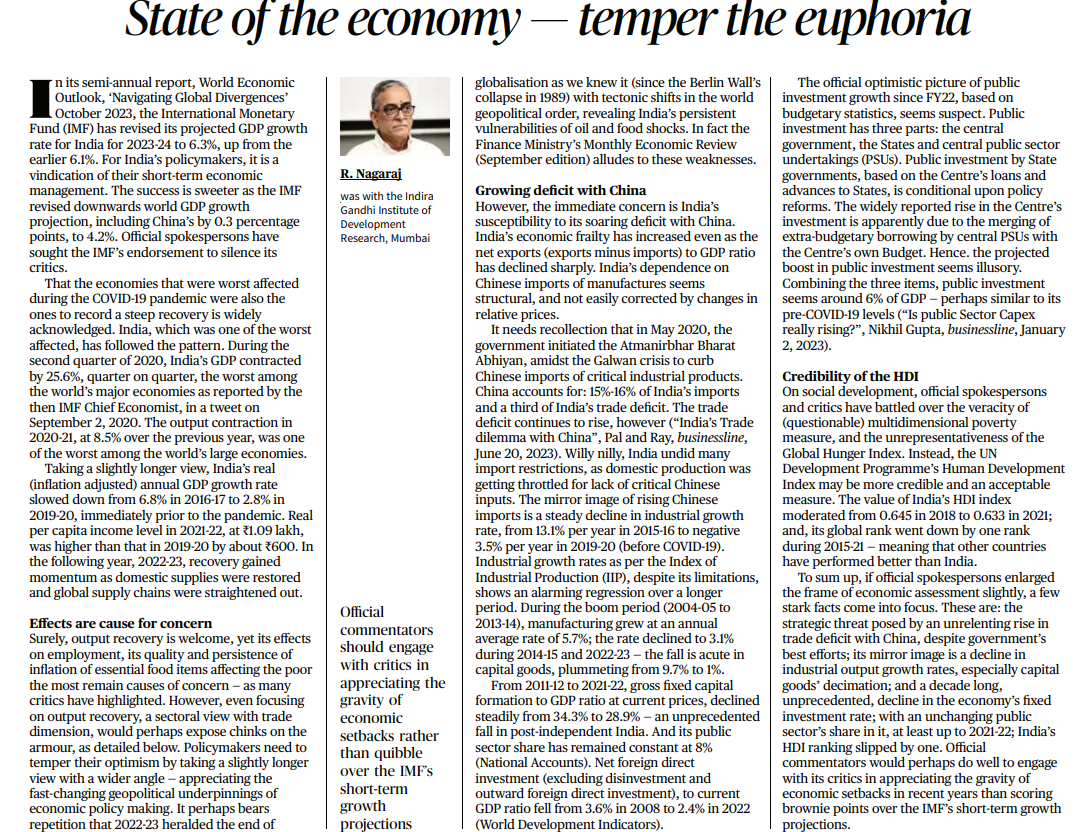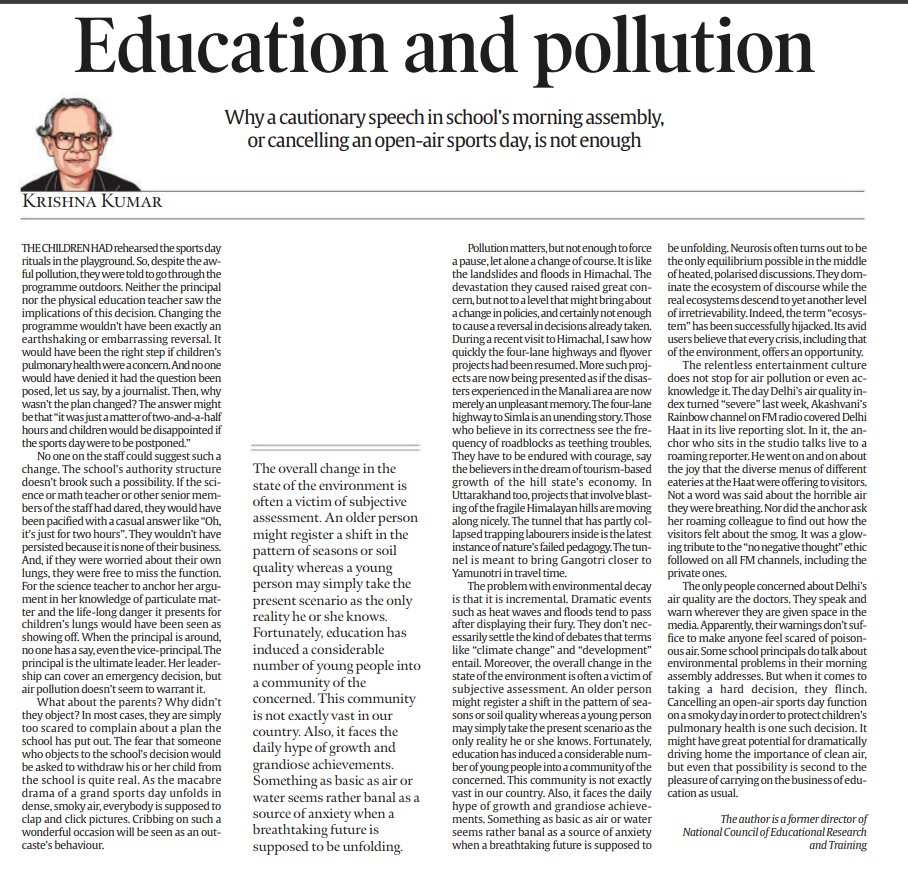Strategic Shift: U.S. Pivot and the Abraham Accords
- The United States, historically the dominant power in West Asia, initiated a strategic shift by redirecting its focus from the region to conventional rivals like Russia and China.
- To maintain influence, the U.S. pursued closer ties between Israel and the Gulf Arabs, culminating in the Abraham Accords during the Trump administration, a policy continued by President Joe Biden.
- The goal was to form a common Jewish-Arab front, fostering relative peace and enabling the U.S. to allocate resources elsewhere.
Tactical Realignment: Gulf Arabs and China
- The U.S.’s deprioritization prompted Gulf Arab states to recalibrate foreign policies for stability and predictability in the region.
- China, with existing ties across the Gulf, seized the opportunity to act as a peacemaker, leading to the Iran-Saudi reconciliation agreement.
- In response, the U.S. intensified efforts on the Abraham Accords, unveiling the India-Middle East-Europe Economic Corridor proposal as an alternative to counter China’s influence.
Re-regionalization of Palestine: Impact of the October 7 Hamas Attack
- Hamas, controlling Gaza since 2007, perceived the U.S.-led shifts as a threat to the Palestinian cause.
- The October 7 Hamas attack aimed to disrupt the Saudi-Israel peace talks, challenging the trend of Arab countries delinking the Palestine issue from engagement with Israel.
- Israel’s retaliatory assault on Gaza, resulting in significant casualties, temporarily achieved Hamas’s goal of re-regionalizing the Palestine issue.
Arab Perspectives and Emerging Realities
- Arabs and Israel initially sought to sidestep the Palestine question in pursuit of a new partnership, as seen in the Abraham Accords.
- After the October 7 events, the Palestine issue resurged in West Asian geopolitics, triggering widespread protests across the Arab world.
- The Iran factor further complicated dynamics, as Iran positioned itself as a leader against Israel, forcing Arab countries to navigate difficult choices between public sentiment and geopolitical considerations.
Setbacks and Challenges for the U.S.
- The U.S.’s reliance on the Abraham Accords faced challenges due to the reemergence of the Palestine issue and Israel’s forceful response to the Hamas attack.
- The situation in Gaza raises uncertainties about the viability of rebooting the Accords and questions Israel’s endgame, potentially hindering U.S. influence in the region.
- The growing autonomy of Arab countries, exemplified by their actions independent of U.S. interests, signals a changing regional dynamic with implications for American influence.
Limits of U.S.-Brokered Accords and China’s Growing Role
- The Iran-Saudi reconciliation, mediated by China, dealt a setback to U.S. influence, showcasing Arab countries’ increasing autonomy.
- Recent events highlight the challenges faced by the U.S.-brokered Abraham Accords and the expanding influence of China-brokered initiatives, particularly the Iran-Saudi détente.
- The crisis in Gaza and the broader regional dynamics underline the evolving role of global powers, with Russia and China gaining space for manoeuvrability.
Conclusion: U.S. Dilemma in a Changing Region
- The crisis in Gaza has brought the West Asian geopolitical landscape back to pre-2005 conditions, but the current context differs significantly from the early 2000s.
- While Russia and China may not replace the U.S. as the dominant power in the region immediately, the evolving presence of other global powers challenges U.S. maneuverability.
The Biden administration’s alignment with Israel’s actions in Gaza has positioned the U.S. in a complex situation, navigating a region in flux with shifting alliances and priorities.
Introduction:
- The International Monetary Fund (IMF) released its semi-annual World Economic Outlook report, titled ‘Navigating Global Divergences’ in October 2023.
- The report revised India’s projected GDP growth rate for 2023-24, indicating a positive outlook amid global economic challenges.
- This editorial analysis analyzes the key points raised in the report and contextualizes them within India’s economic landscape.
- India’s Economic Recovery: A Short-Term Success
The IMF revised India’s GDP growth rate for 2023-24 to 6.3%, up from the previous estimate of 6.1%. This positive adjustment is seen as a vindication of India’s short-term economic management amid the challenges posed by the COVID-19 pandemic. The success is contrasted with a downward revision of global GDP growth projections, including China’s, to 4.2%.
- Economic Setbacks and Recovery
India faced severe economic challenges during the COVID-19 pandemic, with a significant contraction in GDP during the second quarter of 2020. However, the subsequent recovery gained momentum in 2022-23 as domestic supplies were restored and global supply chains normalized.
Despite the output recovery, concerns linger regarding employment, inflation, and the quality of recovery, particularly for essential food items affecting the poor.
- Geopolitical Underpinnings of Economic Policy
The economic analysis emphasizes the changing geopolitical landscape, noting the end of globalisation as known since 1989. Geopolitical shifts reveal India’s vulnerabilities to oil and food shocks, requiring policymakers to consider broader and longer-term perspectives in economic policy-making.
- Rising Trade Deficit with China: An Immediate Concern
A significant concern highlighted is India’s escalating trade deficit with China, underscoring the country’s economic frailty. Despite attempts to reduce Chinese imports, India’s dependence on critical Chinese inputs remains structural, impacting industrial growth rates negatively.
- Industrial Growth Challenges and Declining Investment
The note delves into India’s declining industrial growth rates, especially in the manufacturing sector, and a decade-long unprecedented fall in the economy’s fixed investment rate. The analysis questions the credibility of reported public investment growth, suggesting it might be illusory.
- Human Development Index (HDI) and Social Development
The Human Development Index (HDI) is proposed as a more credible measure for social development. India’s HDI ranking declined slightly, indicating a comparative underperformance in global social development.
- Engaging with Critics and Acknowledging Setbacks
The conclusion urges official commentators to engage with critics, acknowledging the gravity of economic setbacks in recent years rather than solely relying on short-term growth projections. It calls for a broader economic assessment that considers long-term trends and global dynamics.
Conclusion
While India’s short-term economic outlook seems positive, this analysis encourages policymakers and commentators to address persistent challenges, particularly in the areas of trade deficit, industrial growth, and fixed investment rates, to ensure sustainable and inclusive economic development.
Introduction:
- The editorial sheds light on instances of environmental negligence in the face of air pollution, using a school’s decision to conduct a sports day outdoors despite hazardous air quality as a starting point.
- The lack of concern from various stakeholders, including school authorities and parents, highlights a broader issue of environmental apathy.
Inadequate Leadership Response:
- The decision to proceed with outdoor activities despite severe pollution indicates a lack of awareness or concern for children’s pulmonary health by school authorities.
- The principal’s unquestioned authority and the reluctance of staff to challenge decisions reflect a structural issue in the school’s management.
- The editorial suggests that the duration of the event was prioritized over the potential health risks, showcasing a short-sighted approach.
Parental Fear and Silence:
- The editorial explores the fear among parents to object to decisions made by educational institutions.
- The potential consequence of being asked to withdraw their child from school deters parents from raising concerns.
- The societal pressure to conform during events like a sports day, coupled with the fear of being ostracized for objecting, further contributes to the silence of parents.
Broader Societal Apathy:
The piece extends the discussion beyond the school scenario, highlighting a pervasive societal indifference towards environmental concerns.
Using examples from regions experiencing natural disasters, such as landslides and floods, the editorial argues that these events fail to prompt significant policy changes or reversals in decision-making.
The resumption of construction projects in the aftermath of disasters exemplifies a prioritization of short-term economic gains over long-term environmental well-being.
Incremental Nature of Environmental Decay:
- The editorial discusses the incremental nature of environmental degradation, emphasizing how gradual changes may be overlooked or dismissed.
- The subjective assessment of environmental shifts, particularly by younger generations, is highlighted.
- Despite the potential for education to raise awareness, the editorial acknowledges the limited reach of the community of the environmentally concerned in the country.
Media and Entertainment Culture:
- The role of media and entertainment culture is critiqued for its failure to acknowledge or address air pollution.
- The editorial points out a radio channel’s coverage of a market event during severe air pollution, where no mention was made of the hazardous air quality.
- The relentless focus on entertainment and the avoidance of negative narratives contribute to a broader societal apathy.
Conclusion:
The piece concludes by underscoring the need for a paradigm shift in societal attitudes towards environmental issues.
It critiques the prevailing neurosis and polarized discussions dominating public discourse, arguing that these hinder genuine efforts to address environmental concerns.
The editorial calls for a re-evaluation of priorities, emphasizing the urgency of recognizing the long-term consequences of neglecting environmental well-being.




